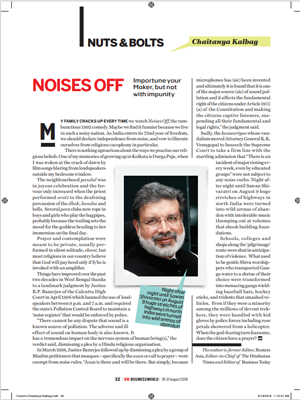NOISE OFF
[Business World]
Published date: 18 Aug 2018
My family cracks up every time we watch Noises off, the rambunction 1992 comedy. Maybe we find it funnier because we live in such a noisy nation. As India enters its 72nd year of freedom, we should declare independence from noise, and vow to liberate ourselves from religious cacophony in particular.
There is nothing uproarious about the ways we practise our religious beliefs. One of my memories of growing up in Kolkata is Durga Puja, when I was woken at the crack of dawn by film songs blaring from loudspeakers outside my bedroom window.
The neighbourhood pandal was in joyous celebration and the fervour only increased when the priest performed arati to the deafening percussion of the dhak, kansha and bells. Several para clubs now rope in boys and girls who play the bagpipes, probably because the wailing sets the mood for the goddess heading to her immersion on the final day.
Prayer and contemplation were meant to be private, usually performed in silent solitude, ekant, but most religions in our country believe that God will pay heed only if S/he is invoked with an amplifier.
Things have improved over the past two decades in West Bengal thanks to a landmark judgment by Justice B.P. Banerjee of the Calcutta High Court in April 1996 which banned the use of loud-speakers between 9 p.m. and 7 a.m. and required the state’s Pollution Control Board to maintain a ‘noise register’ that would be enforced by police.
“There cannot be any dispute that sound is a known source of pollution. The adverse and ill effect of sound on human body is also known. It has a tremendous impact on the nervous system of human being(s),” the verdict said, dismissing a plea by a Hindu religious organisation.
In March 1998, Justice Banerjee followed up by dismissing a plea by a group of Muslim petitioners that mosques – specifically the azan or call to prayer – were exempt from noise rules. “Azan is there and will be there. But simply, because microphones has (sic) been invented and ultimately it is found that it is one of the major source (sic) of sound pollution and it affects the fundamental right of the citizens under Article 19(1)(a) of the Constitution and making the citizens captive listeners, suspending all their fundamental and legal rights,” the judgment said.
Sadly, the kanwariyas whose vandalism moved Attorney General K.K. Venugopal to beseech the Supreme Court to take a firm line with the startling admission that “There is an incident of major rioting every week, even by educated groups” were not subject to any noise curbs. Night after night until Sawan Shivaratri on August 9 huge stretches of highways in north India were turned into wild arenas of abandon with intolerable music thumping out at volumes that shook building foundations.
Schools, colleges and shops along the ‘pilgrimage’ route were shut in anticipation of violence. What used to be gentle Shiva worshippers who transported Ganga water to a shrine of their choice were transformed into menacing gangs wielding baseball bats, hockey sticks, and tridents that smashed vehicles. Even if they were a minority among the millions of devout trekkers, they were handled with kid gloves by police forces including rose petals showered from a helicopter. When the god-fearing turn fearsome, does the citizen have a prayer?






